Transportation is the center of the world! It is the glue of our daily lives. When it goes well, we don't see it. When it goes wrong, it negatively colors our day, makes us feel angry and impotent, curtails our possibilities.
For thousand of year, people knew about a little of huge areas of the world, because there were so few ways of travelling. Today, we can travel by land, water or air to almost every place on earth. And many things that we use, eat or wear to come to us from our country or abroad by some means of transport-by lorry, ship, train or plane.
Man cannot discover new oceans unless he has the courage to lose sight of the shore.
PRIMITIVE TRANSPORT
Walking was only way that early men could get from one place to another. If he wanted to take his belongings with him he had to carry them. Then he learnt how to drag heavy loads behind him on sticks or branches which had been tied together. Later he tried beams across two runners to form a sledge to carry his goods. And people were carried on a litter-two poles with animal skin stretched across them.
People then learnt that they could train animals to carry things on their backs and to pull sledges. The ox, the donkey and later the camel were trained as beast of burden in the Middle East. The dog and reindeer were used in the Arctic, the humped camel and the elephant in India. In the highlands of Central Asia the yak, a type of ox, and in Peru the Ilama, served as packed animals. The horse was the last animals to be trained.

(Early forms of transport, such as the yak-drawn cart and reed sailing boat are still used in some areas of the world. / Image above: credit to this source. Below image: credit to this source)
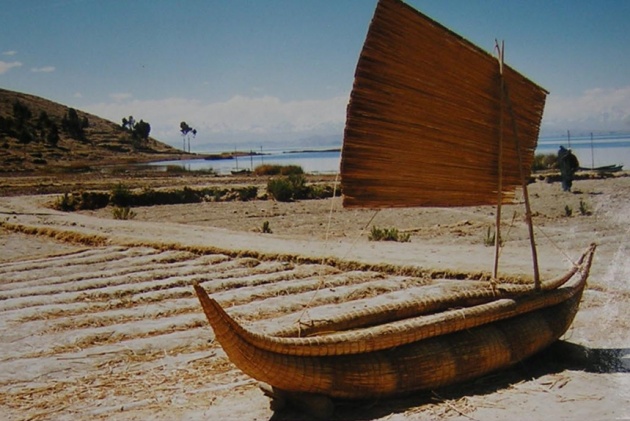
Until the wheel was invented, sledges along with ropes. Other workers at the back of the sledges packed up the rollers over which the sledge had passed and quickly ran round to place them in front. The idea of the wheel may have become from the roller sledge.
No one knows who invented the wheel, but it is thought that the Sumerians may have been the first to use it. They lived in Western Asia about 5,000 years ago. The earliest wheels were probably made of three planks of wood rounded off at the edges, and held together by cross-pieces. A hole was cut through the centre for the axle. Sometimes a solid disc cut from a log was used.
At first the wheel had a very little effect on transport. There were few roads, and those that existed were too bumpy for long trips in a cart. The first wheeled vehicles were used as farm-carts, wagons, and military carriages.
The first boat may have been just a floating log. Then people found they could last several logs together to make a raft, which would carry more people and heavier loads. In the Middle East rafts were made of sheepskins and goatskins that were filled with air. In areas where large trees grew, these were hollowed out with fire or tools to make long, narrow boats called dug-out canoes. Canoes were first pushed along with poles, then with paddles and oars.
Later, man made an important discovery when he learnt that the wind could be used to drive boats. Cloth, grass mats or animal hides were used as sails.
Many of these primitive types of transport are still in use in some parts of the world. Simple forms of wooden sailing vessels and dug-out canoes are used by people living near water. In some mountainous and desert areas goods are taken to market on pack animals or carried by humans.
A plan is the transport medium which conveys a person from the station of dreams to the destination of success. Goals are the transport fees.
EARLY LAND TRAVEL
The need for better transport grew as people began to live in large towns and cities. Town and city dwellers need to make articles that they could exchange for foods. So they needed faster and better ways to transport their goods.
Some of the earliest civilizations began in south-western Asia and Europe about 5,000 years ago. All these ancient civilizations were linked by trade routes. But there were no proper roads; they were unpaved trails. Only the cities had paved roads. During the 16th century B.C., however, the Babylonians built many good roads which were used by caravans, groups of travelers who journeyed together, from Egypt, India and Asia Minor,trade made a Babylonia a wealthy nation. The Persians, after they conquered Western Asia, built even better roads so that they could move armies and supplies.
Of all the ancient peoples, the Romans were the finest road-builders. Smooth, hard road surfaces were to be found wherever the Romans ruled, from England to North Africa. Some sections of the old Roman roads are still used., particularly in England. These were 29 roads leading from Rome, the most famous of which was the Appian Way.
After the fall of the Roman Empire in the 5th century A.D., the roads of Romans had built were no longer kept in good condition. Some were torn up and the stones were used for building houses. Without paving-stones the roads became so muddy in bad weather that vehicles got stuck in the mud. Travel on horseback became the main form of transport.
Etymology
The origin of the word 'travel' is most likely lost to history. The term 'travel' may originate from the Old French word 'travail', which means work. According to the Meriam Webster dictionary, the first known use of the word travel was in the 14th century. It also states that the word comes from Middle English travailen, travelen (which means to torment, labor, strive, journey) and earlier from Old French travailler (which means to work strenuously, toil). In English we still occasionally use the words "travail", which means struggle. According to the Simon Winchester in his book The Best Travelers' Tales (2004), the words "travel" and travail" both share an even more ancient root: a Roman instrument of torture caller the tripalium (in Latin it means "three stakes", as in to impale). This link may reflect the extreme difficulty of travel in ancient times. Today, travel may or may not be much easier depending upon the destination you choose (e.g. Mt. Everest, the Amazon rainforest), how you plan to get there (tour bus, cruise ship, or oxcart), and whether you decide to "rough it." There is a big difference between simply being a tourist and being a true world traveler", notes a travel writer Michael Kasum. This, however, a contested distinction as academic work on cultures and sociology of travel has noted.
Horse-Drawn Vehicles
In medieval times, travelers were sometimes carried on horse-litters, a sort of stretcher on poles to which horses were harnessed. They were still in use in Tudor times, for Anne Boleyn went to her coronation on one.
A trade increased between towns and between nations the need grew for better ways of carrying goods and for better roads. Stage-wagons were the first public vehicles. They were in use in England during the reign of Elizabeth l. Slow and uncomfortable, they were used mostly for carrying goods.
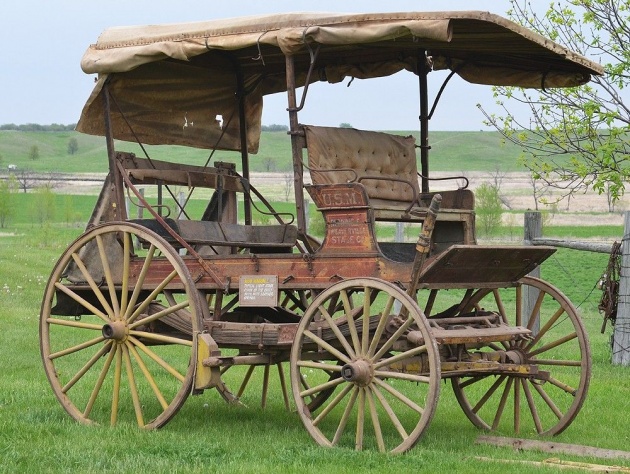
(Image credit)
'Coach' comes from the word kocs, the name of the Hungarian town where coaches were first used in the 15th century. England's first stage-coach ran between London and Chester in 1650. But it was not until 18th century that the stage coaches were widely used. Then they usually carried an armed guard as protection against highwaymen. They were called stage-coaches because they stopped at step points, or stages, along the route. At these stages, tired horses were changed and passengers ate and rested at inns.
Road Become Smoother
England's roads were bumpy, full of holes and muddy right up until the beginning of 19th century, when the first new roads since Roman times were built.
Beginning in 1663, toll-houses were set up along the roads. Each too-house had a turnpike (a pole which swung across the road) to force people to stop and pay a toll. This money was supposed to be used to repair the roads, but few improvements were made until two Scottish engineers were employed by the Turnpike Trusts at the end of the 18th century.
Thomas Telford built roads which had foundations of stone blocks and graved surfaces. John Loudon Mcadam built roads by placing a thick layer of stones in the ground, then putting another layer of stones on top. The wheels of the stage coaches ground the stones together and filled cracks with dust.
Now coaches, wagon and carts could travel much more easily over the roads of England. These vehicles were to be the main forms of transport until the coming of the first passenger trains in 1825.
EARLY TRAVEL ON WATER
For thousand of years it was easier to travel on water than on land. Long before the wheel was invented, ships were used in the river of Nile in Egypt.
The greatest sailors of ancient times were the Phoenicians. They made trading voyages to every part of the known world., from the eastern Mediterranean to the British Isles. Their ships were called galleys. Build of cedar woods, they had a single square sail and two or more rows of oars along each side of the ship. Galleys with two banks of oars were called biremes, and those with three banks, triremes.
The Phoenicians were daring seamen. Their travels to the far corners of the known world added a great deal to the development of trade and the spread of the knowledge.
Mediterranean sailing vessels were improved about the 5th century A.D. by the addition of the lateen sail. This was shaped like a triangle and ran along the length of the ship instead of across it as the square sail did. It could be set a various angles so that the ship could sail across or even against the wind.
Every sailors had instrument for navigation. They sailed by observing the positions of the stars. They also tried to sail near the coast so that they kept within sight of land. But this often mean that they got stranded of shipwrecked on the roads.
With the invention of the first navigational instruments, sailors were able to sail out into the open sea. The compass first came into use in Europe about A.D. 1200. At the same time a few instruments for reading latitude were introduced. With these, and some inaccurately drawn charts and maps, mariners set sail to discover unknown places.
By the end of the 15th century, America had been discovered and men had sailed round the southern coast of Africa to India. The seas became trading highways between nations.
The improvement of the ship design and of navigational instruments continued steadily during the next few countries. Not only did the countries of Europe use their ships for trading; but, as they won more colonies, they also used them to control these distant lands.
It was not until the 19th century, however, that there was any major development in building of sailing ships. In the 1840s a new, faster type of ship called a clipper was invented in America. Although they had long slim hulls and large sails, they still relied on favorable winds and tides.
Canals
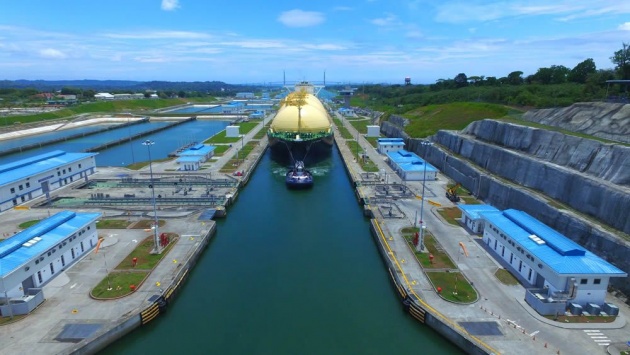
Image credit
A canal is a man-made ditch or channel that is filled with water. Canals provide a direct route for shipping by joining bodies of water that are separated by land or shallow water. They were known to early civilizations, and a large system of canals was developed all over Europe during the late 17th and 18th centuries. But by about 1860 the growth of the railways brought the canal era to an end.
MODERN TRANSPORT
Until the 18th century man could rely only his own energy, the energy of animals and the power of the wind and the water to transport himself and his goods. He could not travel faster than the speed of the good horse. When people learnt to use the power of steam, a great revolution in transport began.
The Age of Railways

(Image credit)
In 1769 James Watt, a Scot, took out a patent for the first economical steam engine. This led to the invention of steam road carriages and steam locomotives.
Richard Trevithick built the first steam locomotive in 1804. It was said to have drawn 70 men and 10 tons of iron. Mine owners found it was cheaper to use steam locomotives to pull coal-carts, than it was to use horses.

(Image credit)
Gradually, the idea of railway trains caught on. The first passenger trains ran on the Stockton and Darlington Railway in 1825. The locomotives were built by the engineers and it was Goerge Stephenson who began, whose famous rocket (above picture) appeared in 1829.
Soon after railways became popular, stage-coaches and goods wagons went out of business. The roads were used less and less as railways trains became the major form of transport.
In our time, steam-engines have been replaced by diesel or electric engines. But railways still remain the most popular way of transporting goods on land.
Steamships
Steam-power completely changed water transport just as it did land transport. Steamboats were built towards the end of the 18th century; an American steamship made the first Atlantic crossing in 1819. Gradually, wooden ships were replaced by iron ones, then later by steel ships which were even stronger.
Beginning in the 1870s, huge luxury liners were built to transport passengers.
Now ships are navigated and controlled with the help of radar, computers and other electronic devices. Some vessels are nuclear powered.
Steam Carriages and Motor Cars
Steam carriages, which carried about 18 passengers and travelled much faster than horse-drawn carriages, were developed in the early 1800s. They became so popular that the new railway companies opposed them because they heard the competition.
For some years before 1890 French, English and German inventors had been experimenting with engines that burned a variety of gases and liquid fuels. By 1885 two Germans. Gottlieb Daimler and Karl Benz were making cars with petro-driven engines. Charles Duryea built the first petrol-powered automobile in America in 1893. Soon after this car appeared, others were introduced. Many of them were flimsy vehicles, with bicycle type wheels.

At first only wealthy people could afford to run the cars. Then an American, Henry Ford, decided to make a car that the working man could afford. He produced the famous model T Ford (image above) in 1908. This went into a mass production in 1912. It was simply made and easy to repair, and could travel up to 40 miles or 64 kilometers per hour.
Transport Above and Below Ground
As town spread and developed during the 1800s, new ways of transport had to be found in the public. There were horse drawn omnibuses in London, but they could not cope with the increasing population. One way of providing transports was to build railway underground. The world's first railway of this kind opened in London in 1863.
Although soot and dirt from the coal burning steam-engine filled the tunnel, the idea was popular and other cities round the world began to copy it. In New York, an elevated 'subway' carried passengers along tracks built high above the streets.
Electrically run trams were introducing towards the end of the last century. They ran on trails rails. Trolley buses, which run on a rubber tyres and received an electric current from overhead wires, replaced the trams in our century. These, in turn, were replaced by buses and coaches.
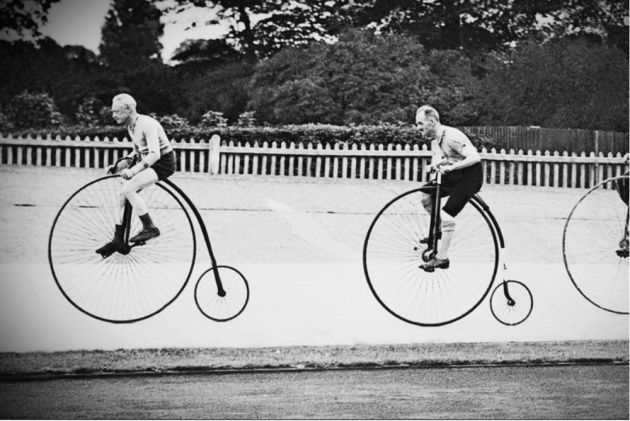
(Image credit)
Bicycles became popular as a form of recreation early in the 19th century. The early bicycles, the penny-farthings (so called because of the different sizes of the front and back wheels were not that safe. But in 1888 John Dunlop invented a rubber tyre filled with air that made riding much smoother and safer. Cycling is still popular today. It is often the cheapest and quickest way of getting through traffic-clogged city streets.
Lorries and Freight Transport
Lorries are being used more and more to haul all sort of goods, from foods to heavy machinery. Recently, a new type of freight-carrying service, a called containing shipping, has become important. Loaded containers are placed on railway wagons and hauled directly to the customer's factory or warehouse. Sometimes the containers are transported by the ship. Container shipping makes it possible for goods to remain undisturbed until they reach the person they are going to. Time and work are saved, and the cost of shipping is reduced. Containers can also be sent by air.
Motorways and Traffic
In our time, road transport-motor, cars, heavy containers, lorries, buses and motor coaches-has brought a new look to all countries all over the world. More and more motorways, tunnels and bridges have been constructed to cope with the amount of traffic. Roads are built on the outskirts of towns and cities to lessen the flow of traffic through them. However, the increase of traffic has also caused new pollution problems.
Man Takes to the Skies
For hundreds of years, man has watched the flight of birds and wondered how he too could fly. The first possibility came in 1783 when the French Montgolfier brothers built the first balloons which could carry passengers through the air. made of paper and silk, they were filled with heated air. The balloon-shade no engines and had to drift where the winds carried them.
Airships, filled with hydrogen or helium gas, came next. Because they had engines, they could be steered in any direction. In 1852 Henri Giffard, a French man, built the first successful airship. Airships were developed further towards the end of the 19th century by count Ferdinand von Zeppelin, a German during World War l, his airships, called zeppelins, carried passengers and were used for dropping bombs on England.
Air transport really began with the Wright brothers in Ohio. They built the first patrol-driven airplane. In December 1903 they made the world's first successful air flight over the beach at Kitty Hawk, North Carolina.
Within a few years, the early flimsy aircraft had become powerful machines capable of carrying heavy loads over long distances high speeds.
After World War ll, the jet-age began Piston-driven planes were replaced by turbo-prop and turbo-jet airliners which could cruise at nearly 600 miles or 966 kilometer an hour. Today, the huge Boeing 747 jumbo jets can carry 375 passengers and 20 tons of freight at this speed.

Supersonic airplanes, such as the British-French Concorde and the Russian TU-144, are designed to fly at speeds over 1,300 miles or 2,092 kilometers an hour. They will cut down the times it takes to fly across the Atlantic to a few hours.
Helicopters, in use 1947, are particularly valuable for speeding up the transport of passengers between major airports and the center of cities. Helicopters, as well as jet planes, are useful for the quick delivery of mail and goods.
NEW FORMS OF TRANSPORT
Since the early 1960s, new forms of transport have been invented.
Hovercraft ride on a cushion of air created by a powerful fan. This cushion lifts the hover-crafts above the surface of the ground or of the water. There are cross-channel services between England and France; and hovercraft have proved very useful over difficult country such as swamps,, ice and uneven surfaces.
(Courtesy of the video: Naked Science)
Design
Hovercraft can be powered by one or more engines. Small craft, such as SR.N6, usually have one engine with the drive split through gearbox. On vehicles with several engines, one usually drives the fan (or impeller), which is responsible for lifting the vehicle by forcing high pressure air under the craft. The air inflates the "skirt" under the vehicle, causing it to rise above the surface. Additional engines provide thrust in order to propel the craft. Some hovercraft use ducting to allow one engine to perform both task by directing some of the air to the skirt, the rest of the air passing out of the back to push the craft forward.
Hover-trains are propelled by jet air-crafts engine and have been tested at speeds of over 200 miles or 322 kilometers an hour. A hover-train runs 1/10 inch or 2.5 millimeters above a single track.
Early efforts
One of the earliest hovertrain concepts predates hovercraft by decades; in the early 1930 Andrew Kucher, an engineer at Ford, came up with the idea of using compressed air was blown out of small metal disks, shaped much like a poppet valve. The Levapad required extremely flat surfaces to work on, either metal plates, or as originally intended, the very smooth concrete of a factory floor. Kucher eventually became VP in charge for Ford Scientific Laboratory, continuing development of the Levapad concept throughout.
It does not appear any effort was put into vehicle use until 1950s, when several efforts used Levapad-like arrangements running on conventional rails as a way to avoid the hunting problems and provide high-speed service. A 1958 article Modern Mechanix is one of the first popular introductions of the Levapad concept. The article focuses on cars, based on Ford prototype "Glideair" vehicle, but quotes Kucher noting "We look up upon Glideair as a new form of high-speed land transportation, probably in the field of rail surface travel, for fast trips of distances of up to 1,000 miles. A 1960 Popular mechanics article notes a number of different groups of proposing hovertrain concept.
What was lacking form all of them was a suitable way to move the vehicles forward since the whole idea of the hovertrain concept was to eliminate any physical contact with the running surface, especially wheels, some sort of contact-less thrust would have to be provided. There were various proposals using air ducted from lift fans, propeller, or even jet engines, but none of these could approach the efficiency of an electric motor powering a wheel.
Hydro-foil craft can move through the water like an airplane flies through the air. Combining features of both boat and plane, the craft is supported by wing-like devices called hydrofoils. When the craft gathers speed, the hull rises above the surface and the hydrofoils 'fly' through the water.
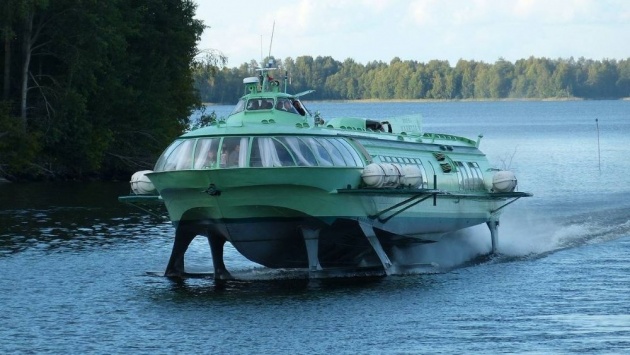
(Image credit)
Modern passenger boats
Soviet-built Voskhods are one of the most successful passenger hydrofoil designs. Manufactured in Russia and Ukraine, they are in service in more than 20 countries. The most recent model, Voskhod-2M FFF, also known as Eurofoil, was built in Feodosiya for the Dutch public transport operator Connexxion.
The Boeing 929 is widely used in Asia for passenger services between the many islands of Japan, between Hong kong and Macau and on the Korean peninsula.
The monorail runs along a single trail which can be positioned above or below the monorail car. Monorails are best suited for busy cities. By running above the ground, they do not interfere with traffic below.
Power
Almost all modern monorails are powered by electric motors fed by dual third rails, contact wires or electrified channels attached to or enclosed in their guidance beams, but diesel-powered monorail systems also exist. Historically some systems, such as the Lartigue Monorail, used steam locomotives.
Ways of carrying people from place to place in the future may include electric rains cars running on tracks. Built to carry cars as well as passengers, they could travel quickly between majority cities and reduce motorway traffic.
Cigar-shaped vehicles could be built to carry passengers through pipelines, either above ground or beneath it. They could travel much faster than other forms of transport,, perhaps racing through the pipelines racing at 2,000 miles or 3,219 kilometers per hour.
The high mileage is achieved thanks in part to the ca's incredibly streamlined body, which has low drag coefficient of 0.189. The average modern automobile achieves a drag coefficient of between 0.30 and 0.35.
-Tracy Staedter on her website-
(Courtesy of the video below: The Atlantic)
Conclusion
If men had not learnt to invent new things, mankind's way of visiting places would be difficult. If men had not built ships and trains, motors, cars, and aeroplanes, few of us would be able to discover new worlds beyond our own. This content gives people, especially the young ones, the story of transport through ages, from the very first beast of burden and medium to the supersonic transports today.
------------------------------------------------------



